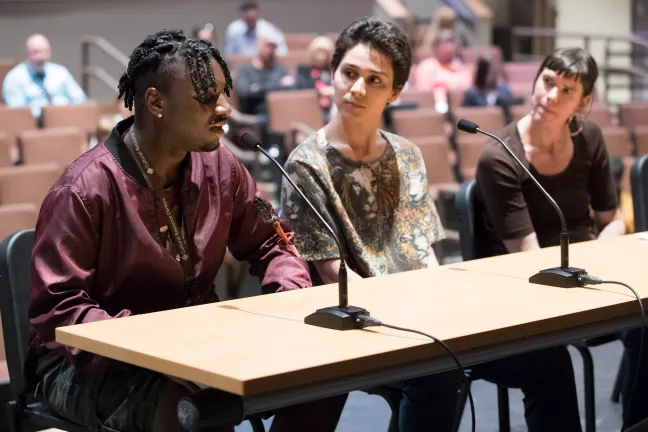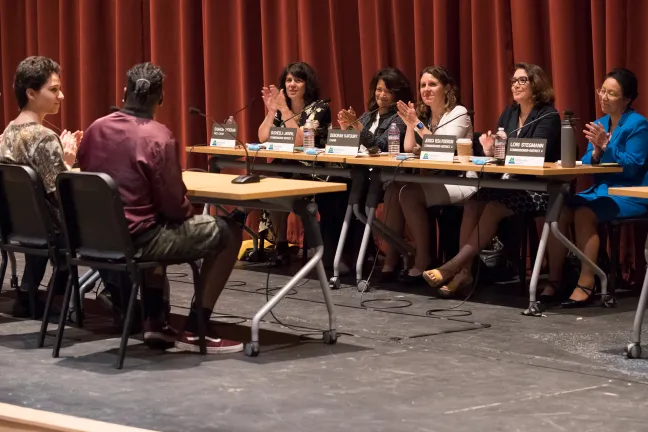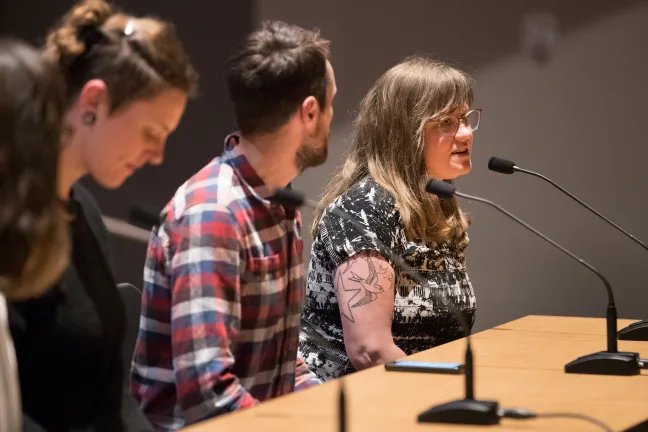Vesper and Marcus were clear about the transformation in their lives made possible by Multnomah County’s investments in the Joint Office of Homeless Services.
In testimony before the Board of Commissioners on Wednesday, May 22, they said transitional housing provided by Outside In had helped them leave the streets and give up drugs, offering hope and opportunity instead.
Vesper said he was receiving mental health treatment and studying business management at Portland Community College. Marcus said he’s using his stability to help others avoid or escape the trauma he endured.
“No one should have to experience homelessness,” he said. “It’s just horrible…. I’m just happy Outside In is here. They help people.”
They were among more than two dozen people who spoke during the fourth community meeting on Chair Deborah Kafoury’s proposed $2 billion budget for the 2019-20 fiscal year. The meeting, held for the first time at Roosevelt High School, was the last before Commissioners are set to pass the budget at a hearing Thursday, May 30.
Speaker after speaker asked the board — often with searingly personal stories — to preserve social services programs that could face reductions this year as the County wrestles with a growing structural deficit and revenue uncertainty.
Many advocated against reducing harm reduction programs in the Health Department that help drug users stay safer. Others urged commissioners to maintain funding for a program called Safety First that helps domestic violence survivors and their children safely manage relationships with their abusive ex-partners.
Selena Coyle said she’s been a Safety First client since 2015, when she divorced her husband after, she said, enduring verbal, physical and sexual abuse. Safety First has a visitation center where Coyle can take her for supervised time with their father — free from the fear that he might harm her or them.
“If this place closes, many families just like mine will have nowhere safe to go for these visits,” she said. “By funding places like Safety First, you are helping to prevent child abductions and other domestic violence issues during supervised visits and custody exchanges.”
Asking to preserve programs
The Chair’s budget plan calls for difficult tradeoffs. It would preserve the County’s investments in homelessness services, SUN schools, and voter access. It also calls for funding the County’s
But it includes proposed cutbacks for programs like Safety First and the Harm Reduction program, which provides medical care and outreach to people who use intravenous drugs through a wound care clinic and syringe exchange sites. It also would eliminate positions in the Sheriff’s Office, including deputies who help with civil commitments and a sergeant who works directly in the jail to address human trafficking.
Tabatha Millican told the Board that “so many of my interactions when I was a drug user weren’t great.”
But the providers she met who helped with harm reduction were there for her, offering not just safe supplies but “compassion and love. They let me know that I have worth and value.”
“I implore you not to cut but to increase the budget for harm reduction,” she said. “Every dollar you spend, you’re saving exponentially down the road.”
Justine Pope, a public health practitioner from North Portland, also requested more funding, not less, for harm reduction.
“At least some of you have identified the opioid crisis as a priority,” Pope said. “I’m wondering how the proposed cuts to harm reduction serve to demonstrate a commitment to that priority.”
Growing structural deficit
Even as County revenues grow, the County’s expenses are growing faster. That gap is forecast to grow to $35 million within five years, in part because of rising personnel costs, but also largely because revenues are artificially limited.
The largest source of funding the Board can allocate comes from property taxes. But voters passed ballot measures in the 1990s that capped property taxes — meaning they aren’t keeping pace with the region’s growth and don’t reflect the true value of Portland’s unprecedented development boom.
“Even when times are good,” Chair Kafoury said Wednesday, “Multnomah County still has to cut its budget.”
Chair Kafoury made clear last month, when unveiling her budget plan, that she had to balance that reality, proposing some reductions while maintaining core services and even making new investments in response to emerging needs.
Among those priorities was continuing the County’s record spending on homelessness services, proposed at more than $26.5 million next fiscal year. Last year, the Joint Office of Homeless Services helped nearly 6,000 people leave homelessness for permanent housing, double the number four years before.
The board is scheduled to vote on a final budget May 30.



